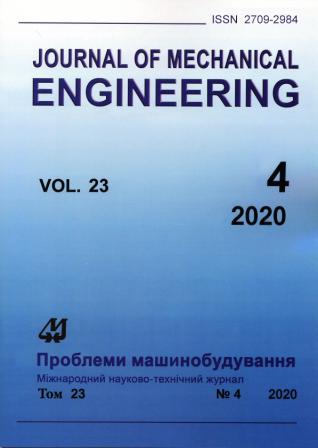Контактное деформирование узла уплотнения трубопровода
Ключевые слова:
турбоустановка, трубопровод, фланцевое соединение, контактная задача, напряженно-деформированное состояние, контактное давлениеАннотация
Исследованы особенности напряженно-деформированного состояния соединительного узла паропровода турбоустановки на основе использования трехмерной расчетной модели конструкции и контактирующих между собой поверхностей. Рассматриваемый узел включает в себя собственно трубопровод, обжимной кожух, состоящий из двух половин, в одной из которых установлен отвод, и прокладку-уплотнитель. Сформирована математическая модель, учитывающая механические нагрузки, вызванные как внутренним давлением пара на стенку паропровода, так и затяжкой крепежей кожуха. Рассматриваемая модель также включает контактное взаимодействие в узле уплотнения на контактируемой поверхности трубопровода, верхней и нижней половин кожуха. Предложена методика решения данной контактной задачи, основанная на применении метода конечных элементов. В основе конечноэлементной модели лежат двадцатиузловые трехмерные конечные элементы с тремя степенями свободы в каждом узле. Для описания контакта и скольжения между поверхностями использовались восьмиузловые контактные конечные элементы. Учет контактных условий осуществлялся при помощи метода штрафных функций. Проведена верификация модели и программного обеспечения, реализующего предложенную методику путем сравнения результатов расчета и экспериментальных данных, полученных на физической модели трубопровода. Физическая модель была изготовлена из низкомодульного материала с соблюдением полного геометрического подобия и такого же соотношения модулей упругости материалов, как и в реальном объекте. Определено напряженно-деформированное состояние соединительного узла реального трубопровода в трехмерной постановке и выявлены наиболее напряженные зоны в узле, требующие повышенного внимания при проектировании и эксплуатации трубопроводов и их соединений. Разработанный подход и программное обеспечение дают возможность определить контактное давление для фланцев горизонтального разъема высоконапряженных корпусов цилиндров мощных паровых турбин, что позволяет избежать большого числа дорогостоящих экспериментальных исследований.Библиографические ссылки
Kalyutik, A. A. & Sergeyev, V. V. (2003). Truboprovody teplovykh elektricheskikh stantsiy [Pipelines of thermal power plants]: A tutorial.St. Petersburg: Publishing House ofSt. PetersburgPolytechnicUniversity, 50 p. (in Russian).
Prigorovskiy, N. I. & Preyss, A. K. (1958). Issledovaniye napryazheniy i zhestkosti detaley mashin na tenzometricheskikh modelyakh [Study of stresses and stiffness of machine parts on tensometric models].Moscow: AN SSSR, 232 p. (in Russian).
(2011). Issledovaniye vliyaniya konstruktivnykh razmerov kozhukha-troynika na napryazhenno-deformirovannoye sostoyaniye uzla uplotneniya osnovnogo gazoprovoda [Study of the influence of the design dimensions of the tee casing on the stress-strain state of the seal assembly of the main gas pipeline]: Report on research work No. D-4089; Research Director – Kabanov, A. F. Kharkov: Special Design Bureau "Turboatom", 96 p. (in Russian).
Turenko, A. N., Bogomolov, V. A., Stepchenko, A. S., Kedrovskaya, O. V., & Klimenko, V. I. (2003). Kompyuternoye proyektirovaniye i raschet na prochnost detaley avtomobilya [Computer design and strength calculation of car parts]: A tutorial. Kharkiv:KharkivHighwayUniversity, 336 p. (in Russian).
Deryagin, A. A. (2013). Formoobrazovaniye i animatsiya 3D-obyektov na osnove tetragonalnoy regulyarnoy setki [Shaping and animation of 3D objects based on a tetragonal regular grid]. Prikladnaya informatika – Journal of Applied Informatics, no. 2 (44), pp. 94–101 (in Russian).
Tolok, V. A., Kirichevskiy, V. V., Gomenyuk, S. I., Grebenyuk, S. N., & Buvaylo, D. P. (2003). Metod konechnykh elementov. Teoriya, algoritmy, realizatsiya [Method of finite elements. Theory, algorithms, implementation]. Kiyev: Naukova Dumka, 283 p. (in Russian).
Stefancu, A. I., Melenciuc, S. C., & Budescu, M. (2011). Penalty based algorithms for frictional contact problems. The Bulletin of the Polytechnic Institute of Jassy. Section: Architecture. Construction, no. 3, pp. 54–58.
Wriggers, P., Vu Van, T., & Stein, E. (1990). Finite element formulation of large deformation impact-contact problems with friction. Computers & Structures, vol. 37, iss. 3, pp. 319–331. https://doi.org/10.1016/0045-7949(90)90324-U.
Guz, A. N., Chernyshenko, I. S., Chekhov, V. N., Chekhov, V. N., & Shnerenko, K. I. (1974). Tsilindricheskiye obolochki, oslablennyye otverstiyami [Cylindrical shells weakened by holes]. Kiyev: Naukova Dumka, 272 p. (in Russian).
Perlin, A. A., Shalkin, M. K., & Khryashchev, Yu. K. (1967). Issledovaniye prochnosti sudovykh konstruktsiy na tenzometricheskikh modelyakh [Research of the strength of ship structures on tensometric models]. Leningrad: Sudostroyeniye, 80 p. (in Russian).
Gudimov, M. M. & Perov, B. V. (1981). Organicheskoye steklo [Organic glass]. Moscow: Khimiya, 216 p. (in Russian).
(2013). Usovershenstvovaniye i vnedreniye sposoba opredeleniya kontaktnogo davleniya v uzle uplotneniya osnovnogo gazoprovoda po rezultatam tenzometrirovaniya [Improvement and implementation of a method for determining the contact pressure in the seal unit of the main gas pipeline based on the results of strain gauging]: Report on research work No. D-4473; Research Director – Kabanov, A. F. Kharkov: Special Design Bureau "Turboatom", 50 p. (in Russian).
Savin, G. N. (1968). Raspredeleniye napryazheniy okolo otverstiy [Distribution of stresses around the holes]. Kiyev: Naukova Dumka, 891 p. (in Russian).
Prigorovskiy, N. I. (1982). Metody i sredstva opredeleniya poley deformatsiy i napryazheniy [Methods and means for determining the fields of deformations and stresses]. Moscow: Mashinostroyeniye, 248 p. (in Russian).
Загрузки
Опубликован
Выпуск
Раздел
Лицензия
Copyright (c) 2021 Serhii A. Palkov, Andrii O. Kostikov

Это произведение доступно по лицензии Creative Commons «Attribution-NoDerivatives» («Атрибуция — Без производных произведений») 4.0 Всемирная.
Авторы, публикующиеся в этом журнале, соглашаются со следующими условиями:
- Авторы оставляют за собой право на авторство своей работы и передают журналу право первой публикации этой работы на условиях лицензионного договора (соглашения).
- Авторы имеют право заключать самостоятельно дополнительные договора (соглашения) о неэксклюзивном распространении работы в том виде, в котором она была опубликована этим журналом (например, размещать работу в электронном хранилище учреждения или публиковать в составе монографии), при условии сохранения ссылки на первую публикацию работы в этом журнале.
- Политика журнала позволяет размещение авторами в сети Интернет (например, в хранилищах учреждения или на персональных веб-сайтах) рукописи работы, как до подачи этой рукописи в редакцию, так и во время ее редакционной обработки, поскольку это способствует возникновению продуктивной научной дискуссии и позитивно отражается на оперативности и динамике цитирования опубликованной работы (см. The Effect of Open Access).

